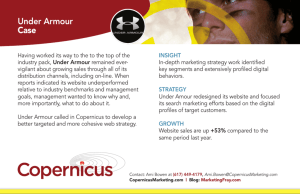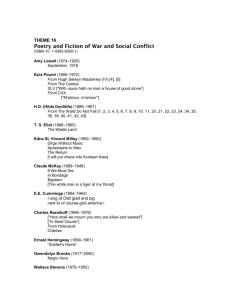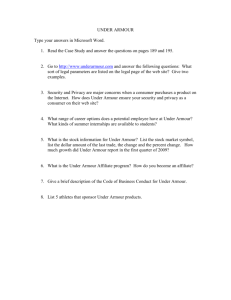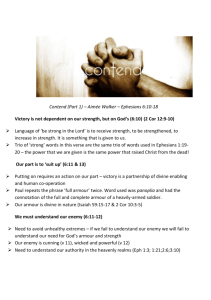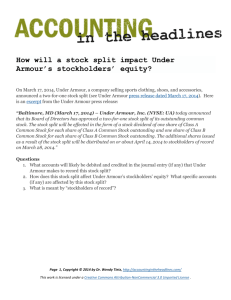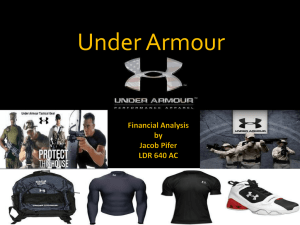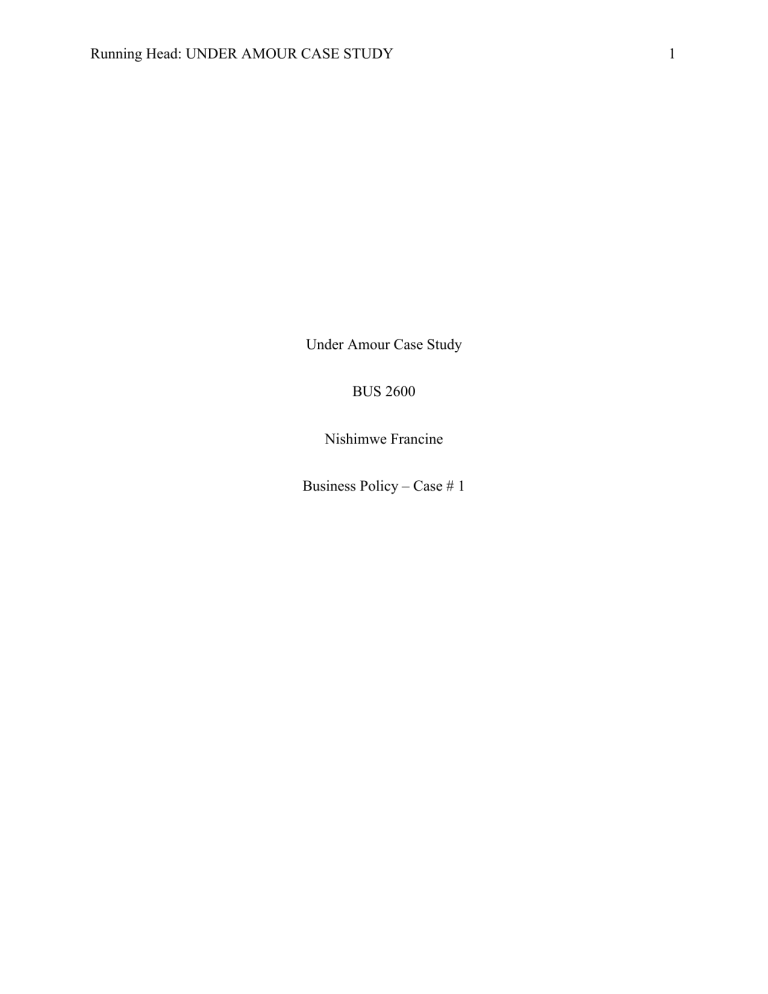
Running Head: UNDER AMOUR CASE STUDY Under Amour Case Study BUS 2600 Nishimwe Francine Business Policy – Case # 1 1 UNDER AMOUR CASE STUDY 2 Under Amour Case Study Kevin Prank, a former football player, started the sportswear firm Under Armour in 1996. Its purpose was to build successful materials that would regulate body temperature and ensure conducive feeling regardless of the environment or activity intensity. Plank sold 500 shirts for $17,000 by the end of 1996, according to Under Armour. Since then, Under Armour has expanded to 15 000 retail locations throughout the world, including 153 of those in the United States. Under Armour has a global revenue of 5.2 billion dollars and employs around 15,800 people (John et al,.2021, pp.292). The company requires a high level of dynamic capabilities to deal with rapid environmental factors and capitalize on advancement potential. Its goal is to improve all athletes via passion, innovation, and an endless search for new ideas. Corporate Governance Under Armour's goal is to make all the customers happy. As it expands into a global company, it is committed to honoring its vision and values in everything they do. The Executive Board has established corporate policies to provide a framework for operating and conducting business to achieve its goal. Mr. Plank was appointed Executive Chairman and Brand Chief of the company in January 2020. He is the most experienced employee in that company since he was the President from 1996 to 2008. Under Amour has a Code of Conduct that outlines the expectations of customers. The experts strive to make our Vision, Mission, and Value a reality through our business practices (Brockhaus et al,. 2019). The revised Code of Conduct stresses the importance of teammates willing to speak up and the tools available to all those who review an ethical concern. External Environment UNDER AMOUR CASE STUDY 3 Several external factors have been either facilitating the growth or hindering the success of Under Amour company. Political Factors; In 2017, Mr. Plank made the mistake of openly calling Donald Trump "an advantage to America," He received massive criticism from the general public and even Stephen Curry, a prominent brand advocate. Legal Factors; In 2017, the Newspaper released an article accusing Under Armour of accounting fraud, resulting in a complicated affair. To maintain the brand from collapsing under the pressure of underperformance, the revenues and profit generated in 2016-2017 were fraudulently stated to make it appear much healthy than they were. The situation caused many problems because it undermined the brand's credibility (John et al,.2021, pp. 302). Indeed, as a result of the issue, the Portnoy Law Firm in Los Angeles is clear that Under Armor, investors should be cautious with their money and aware of the legal possibilities for returning their investment to avoid any severe losses. Economic Factor; As a result of a covid-19 outbreak, the business has encountered difficulty, and Under Armor has taken the short end of the stick. They have experienced substantial losses throughout this time. Considering the difficulties of conducting regular business in lockdown scenarios, several establishments were compelled to close during the epidemic (Warnock and Begley 2019). Despite the virus affecting the whole fashion sector, Under Amour fared the poorest of all the big firms, particularly in sportswear, because it was not as immediately sought after by clients as gyms in many countries were closed as a result of Covid-19. As a result, working out does not necessitate athletic attire. Competition; Under Armour's primary competitors are Nike and Adidas. Both organizations are more established than Under Amour, with higher annual revenues. The competition between the UNDER AMOUR CASE STUDY 4 two corporations is unhealthy because it has already established its market through advertising, sales agents, well-known football teams, and online marketing (James and Whitney 2018). Internal Environment These are the factors within the company that impact the success and approach to operations: Finance; The financial structure of the organization establishes the potential losses. It is also affected by the payments and customer systems of the firm. Changes in interest rates, for instance, or being overly dependent on a single client, for example, can influence a company's bottom line. Organizational and Operational; These are part of the administrative and operational procedures. This includes sloppy or inaccurate record-keeping. Supply chain disruptions, as well as outdated or defective IT systems, must be considered (Kim and Zhang, 2020). If this is not resolved, customers perceive they will be untrustworthy. This issue has been affecting the growth of the under-amour company, which led to disagreement between the employees. Innovation; Any business must innovate to stay relevant and competitive. Marketing is an essential part of the innovation process. Advertising materials in the marketing strategy, staff training, including employee welfare are all possibilities (John et al,.2021, pp.298) Embracing new technologies is a superb method to keep up with technological progress. A lack of creativity can be a danger for a growing firm, for example, if another company has the same problem. Analysis of Strategic Factors Strengths UNDER AMOUR CASE STUDY 5 Portfolio; The extensive product assortment of Under Armor has enhanced the company's standing. The business is not dependent on a particular product (Montgomery et al,. 2018) It also ensures that its sales ratio remains high and continues to grow. Distribution Networks; Under Armor has stunned investors with its rapidly rising market. It was facilitated by the company's unique distribution strategy, which involved using several distribution networks. Adoption of Digital Apps; Under Armour has responded to digitalization with applications like Map My Fitness which has improved its sales elevation, allowing it to expand its funds and realize its disruptive manufacturing capability. Brand Recognition; Under Armour was named the sixth most valued corporation brand in the world in 2017, and it has developed its brand and integrity because of its brand awareness. Weakness Poor Expansion Strategies; Under Armour makes the mistake of concentrating on direct selling rather than internet sales as just a long-term development prospect. Low adoption of e-commerce; Unlike other brands, Under Armour's e-commerce rollout has been gradual. Alot of its current customers are accustomed to purchasing things in-store and paying slowly, making the shift to e-commerce difficult. High Investment Expenditure; Under Armour had taken a risk by increasing its investment spending over the last three years. Within the last two years, it invested $847 477,000 and $153 312,000 consecutively. Its 2017 makeover has raised spending, with more costs to come. Opportunities UNDER AMOUR CASE STUDY 6 Emphasis on Women's Apparel; With these unknowns in 2020, UA female sporting kit sales in the United States rose by 77 percent from January until May 2020 compared to the same duration in 2019. These increases demonstrate the massive potential of focusing on female clothes. Global Markets; Under Armour has more potential profits and wins new clients in overseas markets. Its sales climbed by 57% in the mid of 2017. This statistic indicates a great future. Collaboration; When Kohl's began to sell Under Armour's goods in 2017, the company began cooperating with stores like Kohl's. According to Kevin Marshall, CEO of Kohl's, the relationship was a success. Threats Political Polarization; As a consequence of the Trump administration, the corporation was recently entangled in a scandal. CEO Kevin Plank first supported President Trump, but he later withdrew his backing after his actions sparked public criticism (Jackson et al,. 2018). The company's capacity to operate in the face of political divisiveness has been compromised due to this controversy. Product Capabilities; Under Amour’s headbands and sports, cups have been condemned by experts for the possibility of creating sporting wounds. Injuries produced by its products can tarnish the company’s image and start driving deals. Strategic Alternatives and Recommended Strategy The need for differentiation as well as a new product line; The company should consider more new sports merchandise and concepts. It is insufficient to concentrate solely on high- UNDER AMOUR CASE STUDY 7 quality apparel and footwear. People, particularly women, want additional opportunities and options, so the chosen accessory approach must be updated regularly. Global Expansion; Promoting UA items abroad could help the company stay profitable in the future. It's critical to gain a substantial market share across several countries and show that quality is consistent across borders. Under Armor gives everybody an equal chance, regardless of their moral, ethnic, or other differences. It is vital to pay attention to its competitors (Nike or Adidas). Focus on technology; To remain competitive in the sports sector, UA must focus more on the technical aspects of its operations. The key options that can be provided to the UA team with modern ITs include research online of client demands and expectations, direct contact with current and prospective consumers, and 24/7 assistance Implementation The concept of product uniqueness appears to be the most important and requires the least amount of time to execute. Under Armor has already proved its capacity to differentiate between female and male items. Even so, men and women have very different needs. It is also feasible to introduce a new product line centered on a family and brings together both masculine and female interests. Involve the marketing research team in collecting data, conducting surveys, and evaluating various groups of individuals to clarify what people know regarding UA and its goods. Assess the companies' prospective earnings and profits if many items are sold simultaneously, then implement the strategy as soon as the advantage is identified. UNDER AMOUR CASE STUDY 8 References Brockhaus, S., Fawcett, S. E., Hobbs, S., & Schwarze, A. S. (2019). Boldly going where firms have gone before? Understanding the evolution of supplier codes of conduct. The International Journal of Logistics Management. Jackson, M., Kennedy, D., & O’Rourke, J. S. (2018). Under Armour and the Election of 2016: The Intersection of Politics and Business. The Eugene D. Fanning Center for Business Communication, Mendoza College of Business, University of Notre Dame. James, C. R., & Whitney, K. (2018). Under Armour: repositioning for the global stage. The CASE Journal. John E. Gamble, Margaret A. Peteraf, Arthur A. Thomson jr. Case Studies in Strategic Management. Springer (2021) 281-465 Kim, E., & Zhang, J. J. (2020). Strategic visionary management as enabler of commercial sport management. In Managing Sport Across Borders (pp. 41-63). Routledge. Montgomery, R. T., Ogden, J. A., & Boehmke, B. C. (2018). A quantified Kraljic Portfolio Matrix: Using decision analysis for strategic purchasing. Journal of Purchasing and Supply Management, 24(3), 192-203. Warnock, F. E., & Begley, J. A. (2019). Doing Business: A Managerial Perspective.
